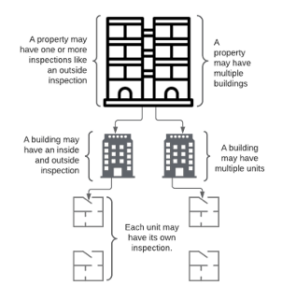Last week (September 15th), we released the ExAM4Inspections extension package – a solution that we regard as a “game changer” for organizations with complex inspection programs.
Why is it so valuable? It provides the following key objects and functionality:
- Inspections Object – is dedicated to consolidating all the information surrounding a particular inspection.
- Deficiencies Object – is vital for complex inspections, because it enables users to maintain a slice in time record of an assessment separately from the lifecycle of the deficiency that was noted. An added bonus is that it enables standard interfaces to other capabilities that we offer around managing work orders and resolving deficiencies.
- Sampling Module – most of our enterprise inspection customers use some form of sampling to determine how they inspect or audit their portfolio, support sampling of the inspections they’ve performed to ensure their quality, or both. Our first iteration covers basic sampling, UPCS sampling, and NSPIRE sampling approaches.
Now, let’s go through how the combination of assignments and inspections can yield granular insights on your inspection process, and how they can be leveraged to support complex sampling requirements.
Assignments and Inspections
By “assignments,” we mean the things a person in the field must do in order to complete a particular task or in this case inspection. Through creating a one-to-one relationship between what needs to be accomplished in order to get the job done and the information that needs to be gathered for a particular inspection, we have helped users to ensure data quality by creating an explicit map of all of the activities that comprise the inspection. Along the way, you can even gather metadata about the assignment, i.e., when it began, how long it took, where it occurred, and who performed it.
That being said, companies that are using our software for an NSPIRE or UPCS inspection may need to perform what amounts to many small inspections in order to deliver a single property inspection:

Complex Property Inspection Model
Under an inspection model like HUD’s NSPIRE, the diagram above would include the following assignments or components, as a part of the overall property inspection:
- Property – 1 Outside Assignment or Inspection
- Building A – 1 Outside & 1 Inside Assignment or Inspection
- Unit 1 (1 unit Assignment or Inspection)
- Unit 2 (1 unit Assignment or Inspection)
- Building B – 1 Outside & 1 Inside Assignment or Inspection
- Unit 3 (1 unit Assignment or Inspection)
- Unit 4 (1 unit Assignment or Inspection)
- Building A – 1 Outside & 1 Inside Assignment or Inspection
In other words, to complete one property inspection, an inspector would need to perform 9 separate assignments and then consolidate the findings.
Workflow Benefits
Here are just some of the benefits of being able to break a complex inspection into smaller pieces:
- Process Analysis. Users will come away with granular insights into how long each part of the process took, an understanding of where the assignments are happening, and customer-specific metadata about each component of a more complex inspection.
- Handling Deficiencies with Ease. Linking deficiencies to an object model makes it easy to tie an issue with a property to a property record, a building deficiency to a building record, and a unit deficiency to a unit record.
- Empowering Teams. Breaking larger inspections down enables teams to easily understand their role and responsibilities in the inspection process.
Treating this entire bundle of assignments as a single inspection results in:
- UI Benefits. Now, you can see each inspection as a single record on a mobile device, gain a high-level overview of the related assignments or deficiencies, or capture a single slice of time more easily.
- Ease of Reporting/Analysis. A consolidation object simplifies reporting, inspection- level analyses, and the creation of high-level dashboards.
- General Understanding. The “inspection object” makes it easy to differentiate the inspection from its component parts.
Sampling Benefits
Often, a complex inspection – whether for housing or equipment – involves analyzing the (many) components of a larger portfolio. For the sake of continuity, we will stick with the property model above. Beyond the fact that it may be cost- or time-prohibitive to inspect every unit or building on a property, there may also be little statistical benefit to it.
By performing inspections on a statistically valid sample, the inspecting organization can maximize the value of the inspection process. In the case of NSPIRE and UPCS, we developed specific sampling models to meet their requirements. But the process is very similar (albeit much more complex than in our basic sampling).
- Complex Sampling Rules: You may have different requirements for the items in your sample (e.g., buildings and units). That’s why we developed our granular model to make specific rules for sampling and creating assignments.
- Matching Inspection Templates to Sample Records: Because our sample is drawn from a larger portfolio of buildings and units, the assignment model enables you to create the inspection types that suit your needs, such as building inside inspection, outside inspection, or unit inspection.
- Sample Record Replacement Rules: Since there are times when a unit or a piece of equipment in a sample may be unavailable for inspection, the granular model allows you to over-sample. In this way, the items that are unavailable can be replaced with units that were randomly selected in order to achieve a statistically valid sample for the overall inspection. We can even order and hide these records from the inspector, until needed, to deter fraud or any bending of the rules that might undermine the validity of the sample.




